Reading Italian Wine Labels: A Volio Imports Guide
Reading an Italian Wine label can be confusing to the untrained eye. We’ve put together this comprehensive guide to help you go from novice to wine nomenclature wiz so you can find the perfect wine! While there isn’t an exact science to this, there are a few basic things you can look for:
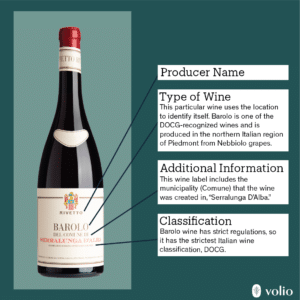
1. Find the Wine Name
The wine name will tell you the type of wine inside the bottle. This sounds simple enough, but there are three primary ways that producers can choose to name their wine.
-
-
- Grape Varietal. Many producers will choose to label their wine by the grape varietal, or the type of grape used to create the wine. Popular examples of this include Pinot Grigio, Barbera, or Sangiovese. Currently, Italy’s Ministry of Agriculture and Forestry (MiPAAF) has documented over 350 grapes and granted them “authorized” status. There are more than 500 other documented varieties in circulation as well.
- Region. The most popular way of labeling a wine in Italy is by region or subregion. Examples of this include Chianti or Tuscana. The region a wine grape is grown in provides particular attributes to the flavor and terroir.
- Brand Name. Some producers will create their own brand name for their wine. This mainly applies to those in the IGT classification, or the one with the most leeway on the production standards for that type of wine. Others may just use the name of their winery as a basis for their wine name.
-
2. Find the Producer Name
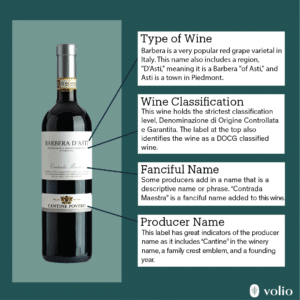
The producer name is the key component to recognizing the overall brand and image on any given bottle of wine. Some producers are famous for certain elements in their wines, so as your taste evolves this can become more important. Many producers will include words such as Tenuta, Azienda, Castello, or Cascina in their name. As one begins to learn more about the different varietals and regions of wine, differentiating the producer name from other components of wine becomes easier. Here you can read through our list of common Italian Wine Label Terms and definitions:
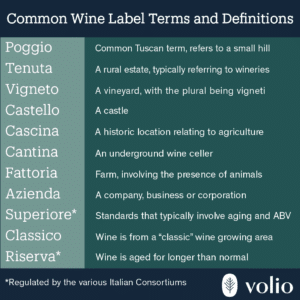
3. Find the Appellation
In 1963 the Italian Government initiated a classification system that breaks the land into various appellations. With a number of modifications and additions over the years, today Italian wine classification can be divided into four main categories. Each Italian appellation depends on a Consorzio — an association of producers and growers who established the laws that determine production regulations for the wine if the producer wants to label under a protected denomination.
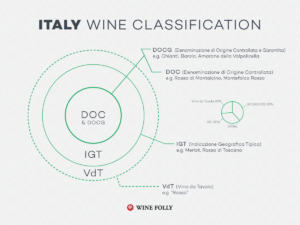
-
- DOCG – Denominazione di Origine Controllata e Garantita. DOCG denotes the highest quality recognition for Italian wines and is comprised of a relatively limited number of first-class wines. DOCG wines must meet a number of additional requirements, including stringent vineyard yield, grape types grown within precise boundaries, specific alcohol levels, and minimum aging. Tuscany and Piedmont carry the most DOCG wines in Italy.
-
- DOC – Denominazione di Origine Controllata. DOC wines must be made in specified, government-defined zones and in accordance with particular regulations derived from Italy’s individual regions. There are over 300 DOC wines in Italy, all adhering to specific vineyard trellising, irrigation and vinification requirements, aging requirements, and alcohol limits.
-
- IGT – Indicazione di Geografica Tipica. IGT wines are often ubiquitous wines grown in specific geographical growing regions; however, there are exceptions with some of Italy’s best wines falling under this category to avoid more stringent regulations associated with DOC or DOCG. IGT also allows for more vineyard experimentation, which can result in diverse and unique wines.
-
- VdT – Vino Da Tavola. VdT wines have the least criteria involved in their classification system, comprised of Italian table wines with the only criteria being that they must be produced in Italy.
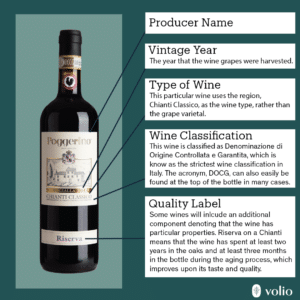
4. Find the Vintage
Vintage refers to the year the grape was harvested. Because harvests can vary from year-to-year, the same wine with a different vintage may be slightly different. If you don’t see a year on the bottle, this usually means the wine is N.V. (non-vintage), which means the wine was made by blending multiple years together.
So, there you have it. In order to read an Italian wine label you need to look for: Wine Name (Varietal, Region, Brand), Producer Name, Appellation, Vintage.
Now you can navigate your way around the wine shop like a pro!
